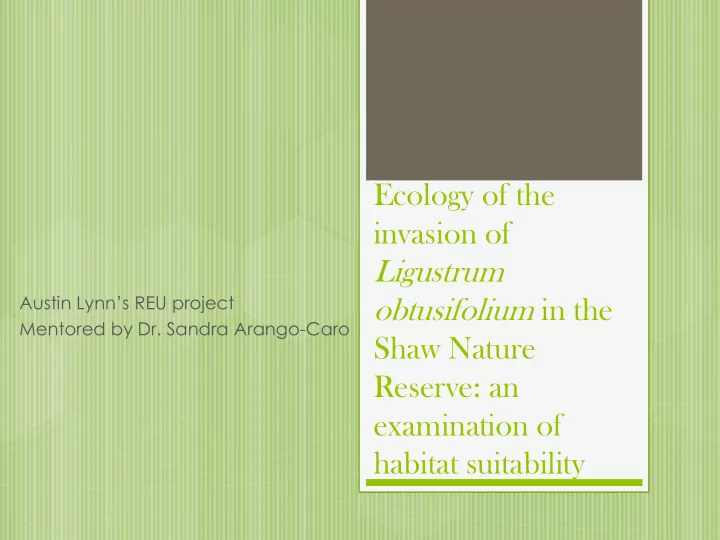

Ecology of the invasion of Ligustrum Austin Lynn’s REU project obtusifolium in the Mentored by Dr. Sandra Arango-Caro Shaw Nature Reserve: an examination of habitat suitability
Why are invasive species relevant? Threat to biodiversity Alter ecosystems by changing dominant vegetation type, soil properties, patterns of herbivory
General attributes of biological invasions Introductions of alien species are generally caused by humans Most introduced species do not flourish in the new environment (Mack et al. 2000) Lag times (Crooks 2005) Roads contribute to the distribution of exotics - disturbance (Flory & Clay 2006) Difficult to control, nearly impossible to eradicate (Grice 2009)
Ligustrum obtusifolium - Border Privet Member of the Oleaceae (olive) family Other invasives- L. sinense, L. japonicum, L. vulgare Introduced from Japan and China in 1860 MO is the western border of the distribution in U.S. The fruit (a drupe) is dispersed by birds Photo: James Trager
U.S. Distribution (USDA 2012)
Traits of Ligustrum obtusifolium The privets form dense thickets which block sunlight from other plants Rapid vertical growth in low light condition (Morris et al. 2002) Chemical defenses (oleuropeins) in leaves that denature proteins and prevent herbivores from receiving nutrients (Konno et al. 1999) Leptoypha hospita and Argopistes tsekooni are insects native to China that can feed successfully on privet (Zhang et al. 2011)
N ¼ mile
Management efforts Privets have been controlled in the reserve with a variety of methods: Cut and paint Arial spray in riparian corridor Controlled burning Spray herbicide-Aquamaster (Glyphosate) Paint herbicide- Tordon (Roundup more effective)
Goals of my project To determine the suitable habitat of L. obtusifolium in the Shaw Reserve in terms of abiotic and biotic factors To determine if distance from roads influences habitat of privet To examine if the height of privet plants is related to herbivory damage and or richness To make recommendations for the future management of privet in the reserve
METHODS Photo by Sandra Arango-Caro
Table 1. Description of study sites. Site Presence of Type of Orientation Slope History of Coordinates privet habitat management One No Woodland NW 40° <10% Cut and 38° 28’30”N paint, 90° 48’11”W logging, burning Two Yes Dense NE 60° <10% Cut and 38° 28’30”N woodland paint, spray 90° 49’41”W herbicides, burning Three Yes Dense NE 50° <10% Logging, 38° 28’09”N woodland burning 90° 49’29”W Four Woodland NE 130° 10-30% Cut and 38° 28’12”N No paint, 90° 48’31”W logging, burning
ROAD Grass 0 m 3 m Focal points 10 m 20 m 30 m
Abiotic Factors - Light availability ( μ mol photons m-2 s-1) - Air temperature and humidity - Soil temperature and moisture
Biotic Factors Species richness Percent cover Proportion of herbivory on privet Presence or absence of fruits Height of focal plants
PCA of environmental patterns by site and distance from road
Relationship of privet height with richness No significant relationship between height of focal plants and species richness for both sites. Height of plant doesn’t coincide with its ability to block sunlight from other plants
Plant height and herbivory 1.6 Y = -0.004x + 0.98 Smaller plants- 1.4 R 2 = 0.25 younger less F 1, 38 =14.37, p=0.0005 Prop Herbivory 1.2 developed leaves. 1.0 0.8 0.6 0.4 50 100 150 Privet height (cm)
Recommendations L. obtusifolium could be on the verge of further invasion into the reserve Management in the reserve should continue Burning seems to be the most effective technique Focus on eliminating reproducing individuals.
Future Studies Analyze the data on species composition between sites infested with privet and uninfested Identifying herbivores Look at how privet habitat suitability varies with soil chemical composition Privet densities
Acknowledgements Dr. Sandra Arango-Caro Dr. George Yatskievych Dr. James Trager Dr. David Bogler Dr. Matthew Albretch Shaw Nature Reserve Missouri Botanical Garden NSF
Recommend
More recommend